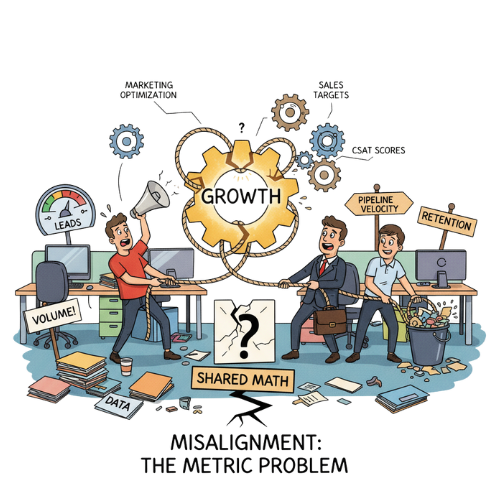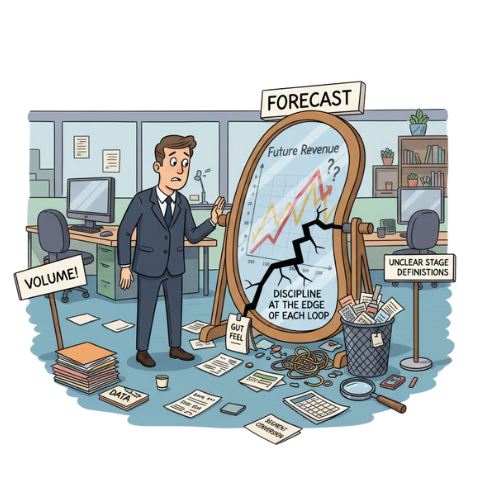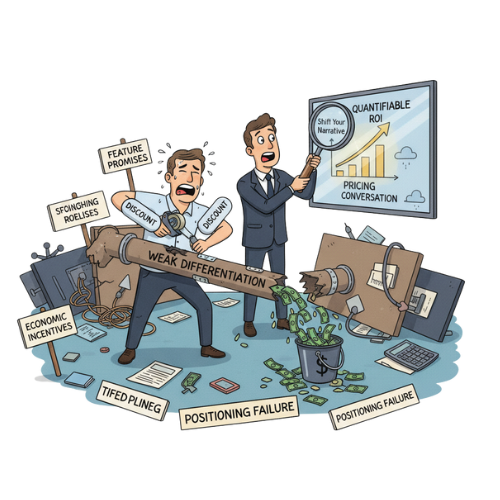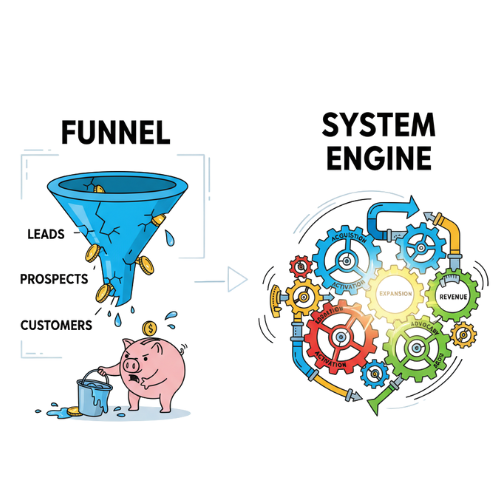11 GTM Strategy Mistakes That Block Growth (And How to Fix Them)
SAASGROWTH
11/18/20256 min read


TL;DR
Most GTM problems aren’t caused by weak messaging, low-quality leads, or pricing mistakes.
They come from something deeper: your go-to-market is a system of loops, not a straight funnel.
When even one loop breaks – acquisition, activation, retention, or expansion – the entire engine loses momentum.
Understanding these loops is the key to building predictable growth.
1. The Real Problem: GTM as a Funnel, Not a System
Most companies still treat GTM like a funnel:
top → middle → bottom → customer.
But growth doesn’t move in straight lines anymore.
It moves in loops:
acquisition → activation → expansion → advocacy → back to acquisition.
If one loop breaks, everything downstream suffers.
Marketing pushes harder. Sales drop prices. Customer success scrambles to retain.
You’re busy – but not compounding.
As Brian Balfour said, “If you optimize functions before optimizing the system, you create local wins that hurt global growth.”
That’s the GTM trap most teams fall into.
2. The First Leak: Heroics Instead of Systems
In the early stages, founders and star sellers are the system.
That’s fine – until growth requires consistency.
The signal: one rep crushes quota while others stall.
The root cause: undocumented plays, undefined ICP, intuition over data.
The fix:
Write down your last 10 wins. Who were they? Why did they buy?
Look for the pattern: what pain started the conversation? what clinched the deal?
Turn that into a one-page “How We Sell” playbook.
Train and iterate every month.
You don’t scale talent – you scale patterns.


3. Misalignment Is a Lagging Symptom
When marketing, sales, and CS aren’t aligned, it’s not because they don’t talk enough.It’s because they don’t share the same definition of success.
Marketing chases volume.
Sales chases conversion.
CS chases retention.
Those loops don’t sync unless everyone aligns on one core metric – like Net Revenue Retention (NRR) or Pipeline Velocity.
Kyle Poyar’s data shows that companies aligned on NRR grow up to 50% faster, because retention and expansion become growth engines, not afterthoughts.
Alignment isn’t collaboration. It’s shared math.


4. Forecasts Are Only as Good as the Loops Feeding Them
If your forecasts are always off, the data feeding them is broken.
Forecasting isn’t a finance problem – it’s a GTM discipline problem.
You can’t predict what you don’t measure consistently.
Start simple:
Define every stage clearly.
Keep CRM data clean.
Track conversion rates by segment, not guesswork.
When founders say, “We need better forecasting,” what they really mean is, “We need better system hygiene.”
👉 If you’re an AI startup struggling to connect your product’s tech promise to real business traction, check out GTM Strategy for AI Startups: How to Move From Hype to Revenue.


5. The Price War Loop
If you’re closing deals only by discounting or promising features, you’re in trouble.
That’s not a sales issue – it’s a positioning issue.
April Dunford would call this “a positioning failure disguised as a pricing problem.
To fix it:
Sell outcomes, not features.
Show what life looks like with you vs. without you.
Build pricing around measurable ROI.
When the value is clear, the price becomes secondary.


6. Retention Starts at Onboarding
Churn doesn’t begin at renewal – it starts at onboarding.
If users don’t hit value quickly, your loops stop compounding.
Set a Time-to-Value (TTV) target.
Top SaaS teams cut TTV by 40-60% once they start tracking it.
Every day you save at onboarding adds weeks to lifetime value later.
7. Focus Is a System Constraint
Every GTM engine has a natural constraint – bandwidth, brand trust, and product readiness.
The mistake is trying to brute-force growth through that bottleneck instead of fixing it.
This is the “growth constraint mindset”: find the slowest loop, not the loudest.
Once you relieve that constraint, the system accelerates without more inputs.
Pick a single North Star (e.g., activation rate) and align all experiments to it for one quarter.
Speed follows clarity.
👉 We broke this down further in Growth Agency vs. Marketing Agency: The B2B Tech Leader’s Playbook for 2025.
It explains how misalignment at the leadership level often starts with the wrong growth partner – and how to fix it strategically.
8. Leadership Drift = System Drift
When leadership isn’t aligned, no system will be.
If your CEO talks about brand, your CRO about quota, and your CMO about leads, you’re driving three cars in different lanes.
Fix it with quarterly GTM design reviews:
Are loops connected?
Are metrics shared?
Is the customer journey seamless?
Real strategy is just everyone saying “no” in the same direction.
9. Churn: The Negative Loop You Don’t Measure
Most teams celebrate new ARR but ignore churn.
A 1% rise in monthly churn cuts annual growth by 12–15%.
To fix it, give retention the same rigor as acquisition:
Track usage, ROI, and sentiment.
Build renewal playbooks.
Run win-back campaigns.
In SaaS Capital’s 2024 report, the best B2B companies keep churn under 5% – because retention isn’t random; it’s engineered.
10. The Invisible Competitor: Indifference
Losing to another vendor hurts less than losing to “no decision.”
That’s not product failure – it’s context failure.
Buyers don’t see enough risk in staying the same.
Reframe the status quo as the enemy. Quantify its cost.
As Andrew Chen says, “The opposite of growth isn’t decline – it’s stagnation.”
Your messaging should make inaction feel expensive.
11. Platform Thinking: The Compounding Loop
Every mature company hits the same ceiling: the product works, but growth slows.
The next phase isn’t another campaign – it’s ecosystem leverage.
Hugging Face turned from a chatbot into the GitHub of ML by opening its ecosystem.
Its community now fuels both adoption and innovation.
Ask yourself:
Can partners extend your value?
Can users contribute assets or data?
Can integrations make you indispensable?
That’s when GTM becomes self-propelling.
The Rebuild Framework — Clarify → Systemize → Scale
Clarify: Who’s your best-fit customer? What’s your motion – PLG, SLG, or hybrid?
Systemize: Codify plays, automate handoffs, install feedback loops.
Scale: Add enterprise motion, community, or partnerships only once your base system compounds.
Balfour would call this moving from “tactics in isolation” to “systems in iteration.”
Each loop reinforces the next – acquisition improves retention, retention fuels advocacy, and advocacy lowers CAC.
That’s compounding GTM.
Closing Note:
If this sounds familiar – you’re not alone. Most growing B2B teams face these same leaks before they scale.
At BriskFab, we help founders turn reactive GTM systems into predictable growth engines – through clarity, alignment, and automation.
Book a 30-minute GTM Strategy Call to audit your system and identify the one fix that could change your next quarter’s results.
→ Schedule Your Strategy Call with BriskFab
FAQs
1. Why is my B2B go-to-market strategy not driving consistent revenue?
Because you’re optimizing channels, not systems. When sales, marketing, and product run separate plays, your GTM engine leaks and growth becomes unpredictable.
2. How can I fix a broken go-to-market engine in my SaaS startup?
Run a GTM audit — map acquisition, activation, and retention. Define your ICP clearly, align team metrics, and rebuild around measurable value, not activity.
3. What should a go-to-market audit include for an AI or SaaS company?
It should analyze ICP fit, funnel conversion data, pricing alignment, messaging clarity, and team handoffs — to uncover exactly where revenue systems leak.
4. How long does it take to rebuild a working go-to-market strategy?
Expect 8–12 weeks to stabilize your GTM loops. The real payoff comes when clarity, process, and feedback loops compound into predictable growth.
5. What are the most important GTM metrics for B2B and SaaS growth?
Track pipeline velocity, win rate, activation rate, and Net Revenue Retention (NRR). These reveal efficiency, predictability, and compounding growth quality.
6. What’s the difference between a go-to-market strategy and a marketing plan?
Marketing drives awareness; GTM connects every growth function — from product to revenue. GTM defines how your company wins and keeps customers.


